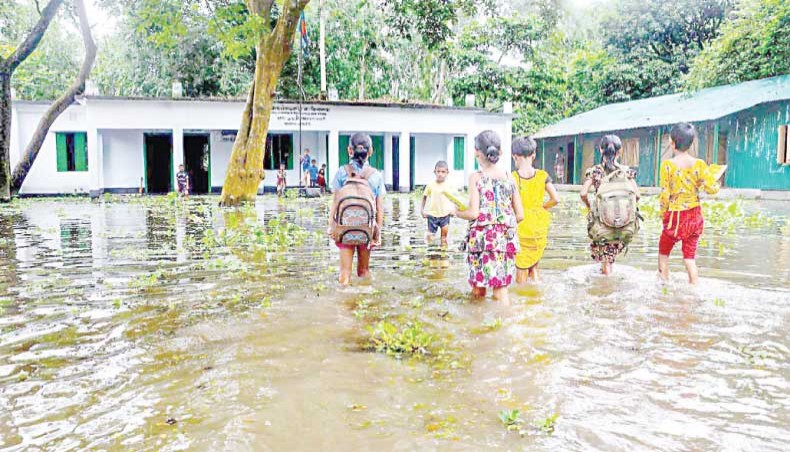Flood situation remains unchanged
Acute fodder crisis, coupled with an outbreak of diseases, is forcing people in the flood-affected districts to sell off their livestock.
The affected people have been left with no alternative but to start selling their livestock as the flood situation stayed unchanged on Sunday.
Vast areas of land still remain submerged in water, with the price of rice husks and straw going up every day.
Although the flood has stayed for over two weeks in northeastern region and for several days in northern Bangladesh, livestock officers there said that they could not offer a complete picture of the situation yet.
In Moulvibazar, the district livestock officer, Hedayet Ullah, said that reports of fodder crisis and breaking out of diseases such as diarrhoea and foot and mouth prompted him to request a supply of 7,510 tones of cattle food and 21 types of medicines from the headquarters.
The headquarters did not respond to Hedayet’s request, reported our Moulvibazar correspondent.
‘I cannot wait anymore for the help to arrive,’ said Chhatir Mia, a farmer in Borlekha’s Bholarkandi village.
He and his family shared a single room with their four cows and five goats since being hit by the flood three weeks ago.
Two of the cows contacted diarrhoea several days ago. All the five goats are suffering from foot and mouth disease too.
‘I will look out for a buyer to sell the animals,’ said Chhatir.
Almost all of the 13 cows and goats owned by his three neighbors are also suffering either from diarrhea and foot and mouth disease.
‘Over 90 per cent households owning livestock in our area are faced with the similar situation,’ said Abdur Rahim, another farmer in Bholarkandi village.
According to the district livestock office, in the 35 unions completely affected by the flood, there are 1,71,330 cows, 33,033 buffaloes, 5,00,753 goats and 7,348 lambs.
Our staff correspondent in Sylhet reported that the fodder crisis took a serious turn there too.
The chairman of Sayedpur union in the flood-hit Osmani Nagar upazila said that many in his union had to sell their livestock at half the actual price.
The district livestock officer, Nurul Islam, said they started distributing fodder and medicines in the affected areas Sunday.
Our Kurigram correspondent reported that fodder crisis forced many in the district to sell their domesticated animals too.
Our Lalmonirhat correspondent reported that the situation deteriorated there with a massive river erosion taking place, displacing 2,500 people over the last couple of days.
Our Jamalpur correspondent reported that the authorities suspended classes at 55 educational institutions in four upazilas as the flood situation worsened in the district.
Around 40,000 people have been marooned in the district since being hit by the flood three days ago.
Still, the river Jamuna is on the rising trend, flowing over 36 cm above the danger level.
The flood forecasting and warning centre said that the river would continue to rise in the next 24 hours.
The FFWC forecast on Sunday morning also showed that four other rivers — Surma, Kushiyara, Kangsha and Dhaleshwari — were flowing over the danger level at nine points across the country.
The FFWC forecast that the river Ganges and Padma may continue to rise in the next 48 hours while the river Brahmaputra may remain study in the next 24 hours.
Of the 90 stations monitoring flood situation across the country, 51 marked rise on Sunday.
The flood situation may deteriorate following heavy to extremely heavy rainfall in the upstream on Sunday.
The Indian met office said that West Bengal and Assam and Meghalaya were likely to receive extreme rainfall throughout Monday.
United News of Bangladesh reported that about 50,000 people were marooned in Sariakandi upazila of Bogra as the flood situation deteriorated there.
News Courtesy: www.newagebd.net











